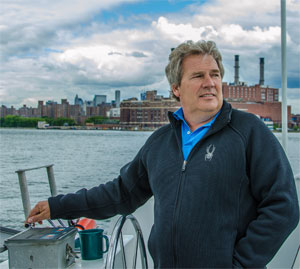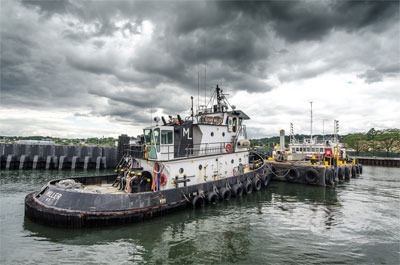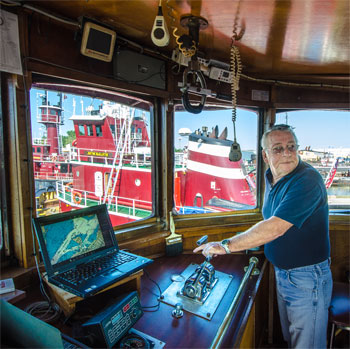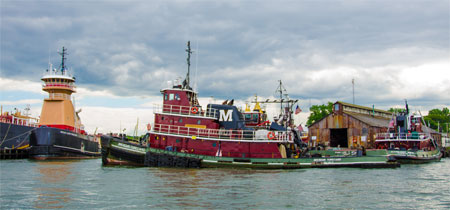In recent times, the pressure to acquire industrial waterfront property and to develop it into an urban environment has been unrelenting. But, so far, “Tugboat Alley” on New York City’s Staten Island has survived. And things look brighter for the island’s north shore industrial waterfront lining Kill Van Kull and Arthur Kill, two channels that separate New York from New Jersey and form the entrance to both harbors.
Not very long ago, the waterfronts lining America’s port cities were, for the most part, the domain of heavy industry — wharves, warehouses, factories, shipyards, fish processors, chandlers, tugboat companies and the like. Greasy spoons, bars and bordellos shared an environment ripe with the smell of diesel fuel and rotting fish, often referred to as the smell of money. The genteel roamed elsewhere.
Today the aroma wafting along urban shores and caressing the balconies of condominiums rising up from waterfront walkways, punctuated by green parks and marinas, often comes from upscale waterfront restaurants.
 |
|
Capt. Glen Miller, owner of Miller’s Launch, at the helm of the 100-foot crew boat Rosemary Miller. |
 |
|
Miller's Launch operates a fleet of 70 vessels, including the 68-foot tug Susan Miller. |
Tugboat Alley is home to many of the country’s major tug companies including McAllister, Moran, Penn Maritime (recently bought by Kirby Corp.), Reinauer, Bouchard. Smaller companies with a tug or two, such as Brown Towing, are located there. Related industries such as Great Lakes Dredge & Dock, Caddell Dry Dock, Bay Shipyard and Clean Waters, a barge and bilge cleaning company, occupy the shoreline accessed by Richmond Terrace.
For Steve Kress, vice president of operations for McAllister Towing and vice chairman of the Port of New York and New Jersey’s Tug and Barge Committee, balance is the answer in the struggle between industry and urban development.
“The north shore of Staten Island is full of tug companies and is very vibrant,” said Kress. “There are hundreds of people employed in our business along the Kills. Everybody wants access to the water. I’d like a place on the water. We understand that, but there has to be a blend of the two: commercial interests and the aesthetics of the waterfront. We’re not saying that we own the waterfront. We’re saying the water has to be shared.”
Kress recalls when McAllister had Tug & Barge Dry Docks, the company’s repair yard at the foot of Pavonia Avenue in Hoboken, N.J. Until 1986, that is. “The city foreclosed on the property and kicked us out. By eminent domain the city of Hoboken turned Tug & Barge into condos and office buildings.”
But the relationship between the Staten Island waterfront industries and the New York City Economic Development Corp. (EDC) is much improved. “The city and the EDC are on board with us now and are very helpful,” Kress said. “They understand the need to share the waterfront. That’s a big change from the past. We’ve gone from no contact to constant contact. Now they are in the forefront and we take politicians on tugboat rides so they can see the issue from the water side.”
With Caddell Dry Dock close by and Clean Waters a stone’s throw away, Kress is in tugboat heaven. He says that if Caddell had to move it would be a disaster for the local tug companies. “It’s a godsend,” he said. “And then there is Clean Waters, a place to discharge our gray water and black water, and to clean our bilges. It’s the only place to properly dispose of it. This is an ideal home base for us.
“We have very limited options left to us when it comes to places to move to if it came to that. We’d have to increase our costs, and then so would our clients, and ultimately the consumer would pay more. This place along the Kills is the key to the way we live. We’ve been squeezed out of places before, but here is where we make our last stand.”
Miller’s Launch is located adjacent to the St. George Ferry Terminal on Staten Island, facing Manhattan. Although the location is around the corner from the Alley, Glen Miller is as concerned about waterfront development as his colleagues on the Kills are. Miller boasts 70 pieces of floating equipment, ranging from launches, crew boats, tugboats and truckable tugs, to a TowboatUS franchise with five rigid-hulled inflatable boats.
Miller, on a tour of the harbor aboard the 95-foot crew boat Rosemary Miller, explains the value of his location and describes the diversity of infrastructure projects that Miller’s Launch provides in the harbor. “Most companies focus on crew boats or tugboats, etc., but we have boats from every column, from 25 to 190 feet. Our focus is not being focused. We are the small-boat providers of New York.”
We idle to observe Gabby L Miller, a 26-foot, 700-hp truckable tug that is moving construction barges on a waterfront development project for the contractor Phoenix Marine. Miller’s yard crew builds the little tugs at the company’s shop.
 |
|
Capt. Richard Messier backs Elizabeth McAllister from its base on the Kill Van Kull. |
“It’s shallow-water work. We use the heck out of these little boats. If one isn’t enough we put in another one. We do the support work moving the crane barges and demolition barges around. I have another four boats up Newtown Creek doing survey work. They’re the platform for shallow-water work.”
At Homeport, Capt. Adam Clark was at the helm of the 68-foot conventional tug Susan Miller, working with a Weeks Marine barge on the new FDNY Marine Nine facility. At Governors Island, a redeveloped Coast Guard base that is now a city park, Miller built and deployed a 70-foot gangway that will hold 50 tons of rolling stock.
The gangway has a ramp to accommodate a drop transom on Sorenson Miller and Rosemary Miller. So far the company has landed heavy equipment for the park development, a Corning Museum of Glass exhibit, 18-wheelers loaded with film industry equipment and the trucks for a Dave Matthews Band concert.
“I need to be in the harbor, especially for my launch service,” said Miller. “My clients are there. If I had to move I’d be out of business. I’ve been moved twice. I’m in my third location. The first was when the Navy moved into Homeport. Now they’re gone and they’re building condos there. It’s a bit annoying to find out that the condos might win, but now the city seems to be seeing our worth.”
In the Kills we cruise by several of the tug companies, shipyards and a mountain of salt at Atlantic Salt’s storage site where the road salt waits, ready for the slippery city streets this winter. “Take that away and it will drive up the cost of salt,” said Miller.
“But the good news is it isn’t too late. The city is getting it. I’m an entity and there is a struggle between condos and commercial interests and the city is seeing that we are a part of the infrastructure and we make it happen.”
Capt. Eric Johansson is executive director of the Port of New York/New Jersey’s Tug and Barge Committee and an associate professor holding an award for Excellence in Teaching at the State University of New York (SUNY) Maritime College. He also founded the Towing Forum, held at SUNY Maritime College for the past 12 years.
“We’ve already lost a lot of commercial waterfront in the battle between condos and commercial interest,” he said. “We can’t lose any more. Once you lose it you can’t get it back.”
Johansson relates how a Maritime Support Services Location Study compiled by SUNY Maritime College staffers for the EDC resulted in saving the Brooklyn Navy Yard from a complete redevelopment. GMD Shipyard, which boasts the largest dry docking facility in New York City, is alive and well sharing the historic site with a host of redevelopment projects.
“Prior to the report, the EDC and other government bodies were not aware that the maritime industry was still vibrant and alive in New York Harbor,” said Johansson. “They thought it was dead and the waterfront it had occupied was ready for redevelopment. Now they understand that it is alive and is needed by the city as part of the infrastructure.”
Johansson explains that there are no dry bulk or general cargo docks, nor is there a heavy lift access site remaining in the city. “What if Con Ed needs to bring in a transformer?” Johansson said, referring to the electric utility. He further states that the city needs the efficient distribution of petroleum and aggregate that tank and deck barges provide.
“One small 20,000-bbl tank barge is equivalent to 168 5,000-gallon-capacity fuel trucks on the road. One scow takes the place of 60 18-wheelers. And we pay good taxes and put a lot of people to work. The city has begun to recognize the significance of the loss if medium- and small-sized ports within the larger port disappear.”
Infrastructure for the efficient transport of essential cargoes within a port seems simple enough to grasp, but both Kress and Johansson emphasize the statistics that color the marine industry much greener than truck and rail.
“The Europeans have it down to a science,” said Kress. “They’ve taken the trucks off the roads and put the cargo on barges, doing what we call ‘short sea shipping.’ If you put 400 boxes on a barge you take 400 trucks off the road. If you take the trucks off the road, you take away traffic jams. The thing about the Marine Highway is that it is a win, win, win. A win for the environmentalists, a win for our industry and a win for the consumer.

